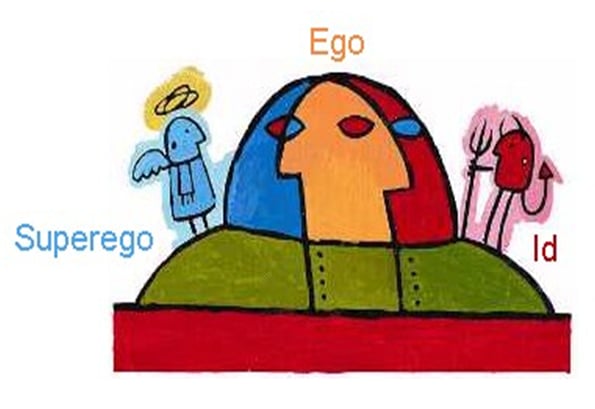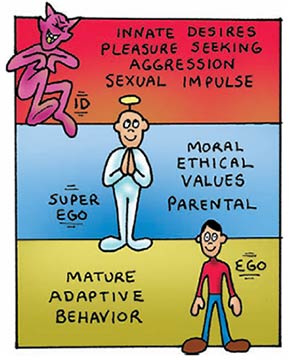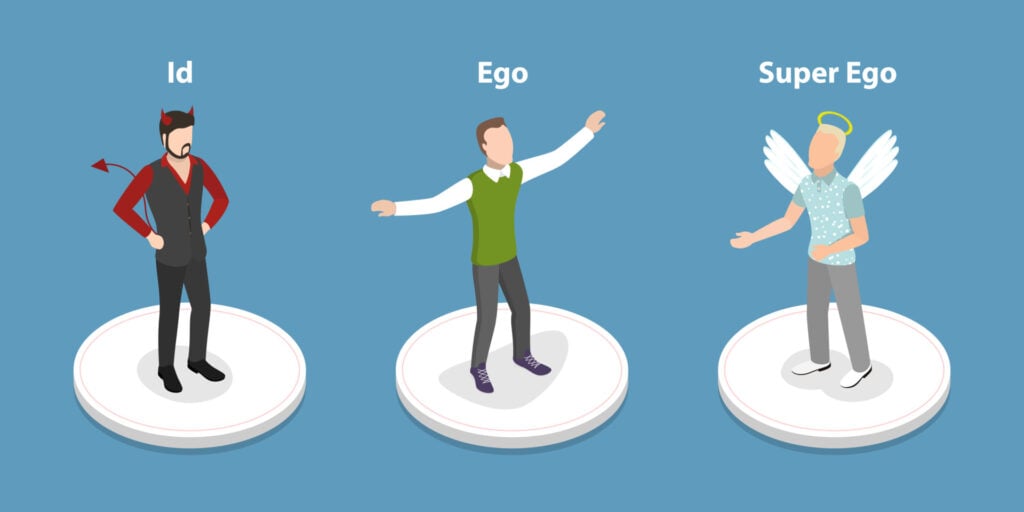On This Page:
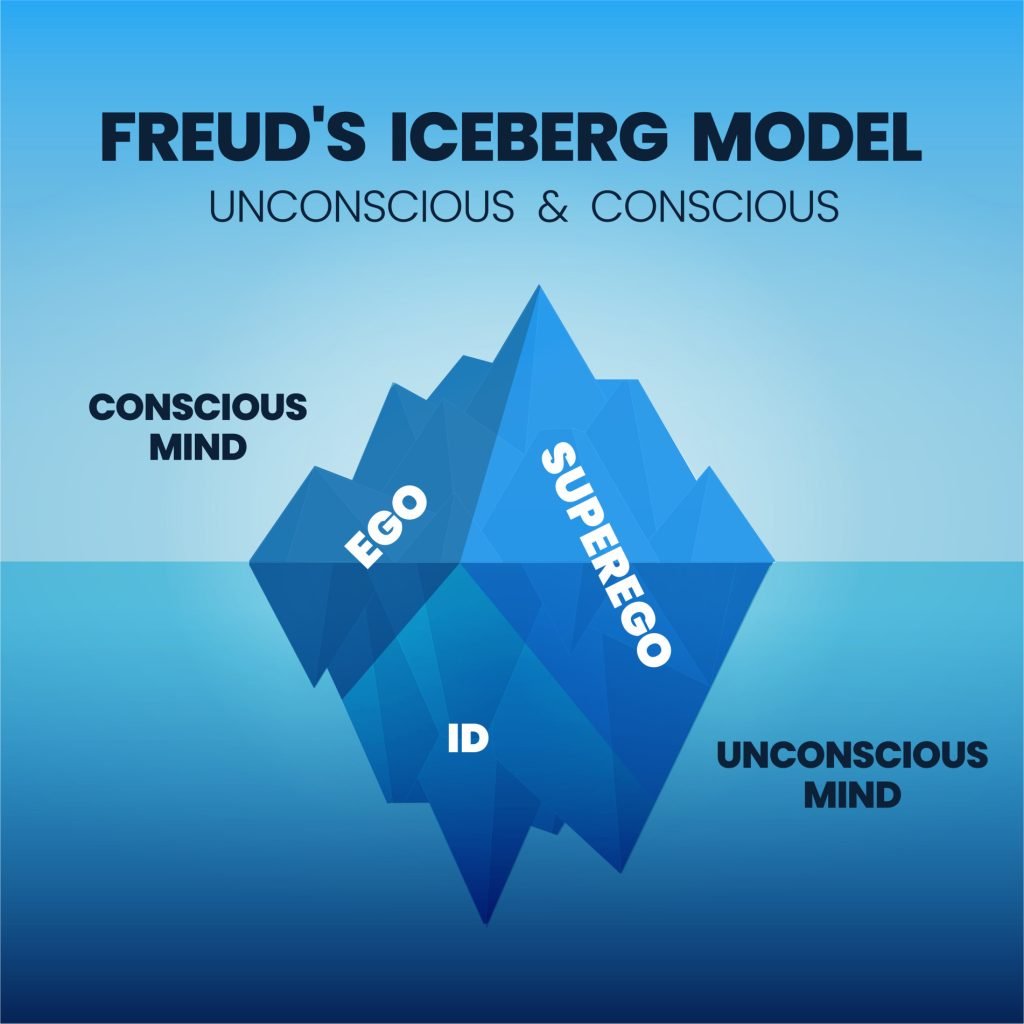
Perhaps Freud’s single most enduring and important idea was that the human psyche (personality).
Freud’s personality theory (1923) saw the psyche structured into three parts (i.e., tripartite), the id, ego, and superego, all developing at different stages in our lives.
These are systems, not parts of the brain, or in any way physical, but rather hypothetical conceptualizations of important mental functions.
According to Freud’s psychoanalytic theory, the id is the primitive and instinctual part of the mind that contains sexual and aggressive drives and hidden memories, the super-ego operates as a moral conscience, and the ego is the realistic part that mediates between the desires of the id and the super-ego.
Although each part of the personality comprises unique features, they interact to form a whole, and each part makes a relative contribution to an individual’s behavior.
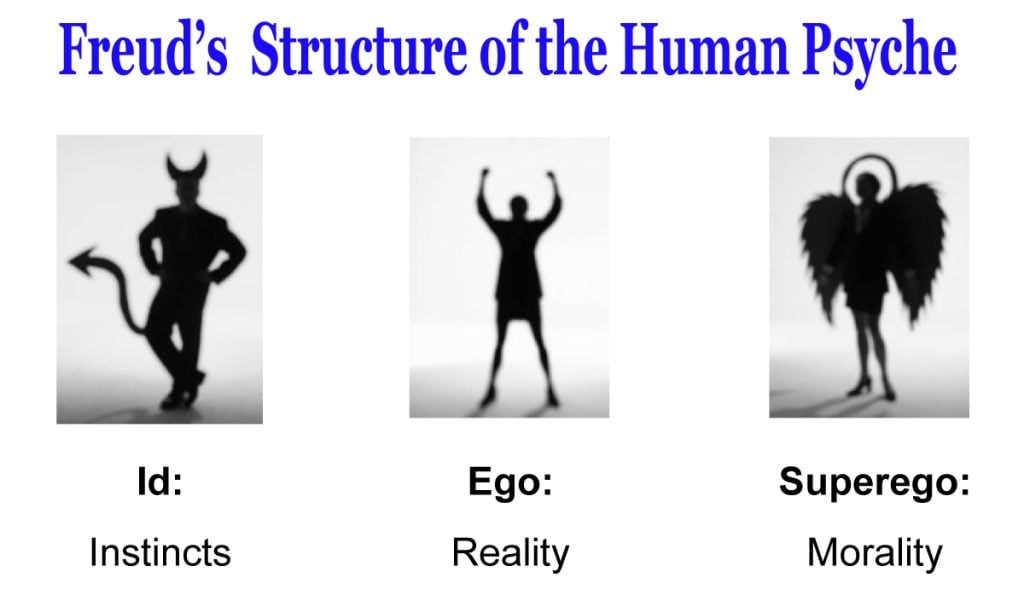
What is the Id?
The id is the primitive and instinctive component of personality.
The id is a part of the unconscious that contains all the urges and impulses, including what is called the libido, a kind of generalized sexual energy that is used for everything from survival instincts to appreciation of art.
The id is the impulsive (and unconscious) part of our psyche that responds directly and immediately to basic urges, needs, and desires. The personality of the newborn child is all id, and only later does it develop an ego and super-ego.
The id engages in primary process thinking, which is primitive, illogical, irrational, and fantasy-oriented. This form of process thinking has no comprehension of objective reality, and is selfish and wishful in nature.
The id operates on the pleasure principle (Freud, 1920), that every unconscious wishful impulse should be satisfied immediately, regardless of the consequences.
When the id achieves its demands, we experience pleasure, and when it is denied, we experience ‘unpleasure’ or tension.
The id comprises two kinds of biological instincts (or drives), including the sex (life) instinct called Eros (which contains the libido) and the aggressive (death) instinct called Thanatos.
Eros, or life instinct, helps the individual to survive; it directs life-sustaining activities such as respiration, eating, and sex (Freud, 1925). The energy created by the life instinct is known as libido.
In contrast, Thanatos, or death instinct, is viewed as a set of destructive forces in all human beings (Freud, 1920).
When this energy is directed outward onto others, it is expressed as aggression and violence. Freud believed that Eros was stronger than Thanatos, thus enabling people to survive rather than self-destruct.
The id remains infantile in its function throughout a person’s life and does not change with time or experience, as it is not in touch with the external world.
The id is not affected by reality, logic, or the everyday world, as it operates within the unconscious part of the mind.
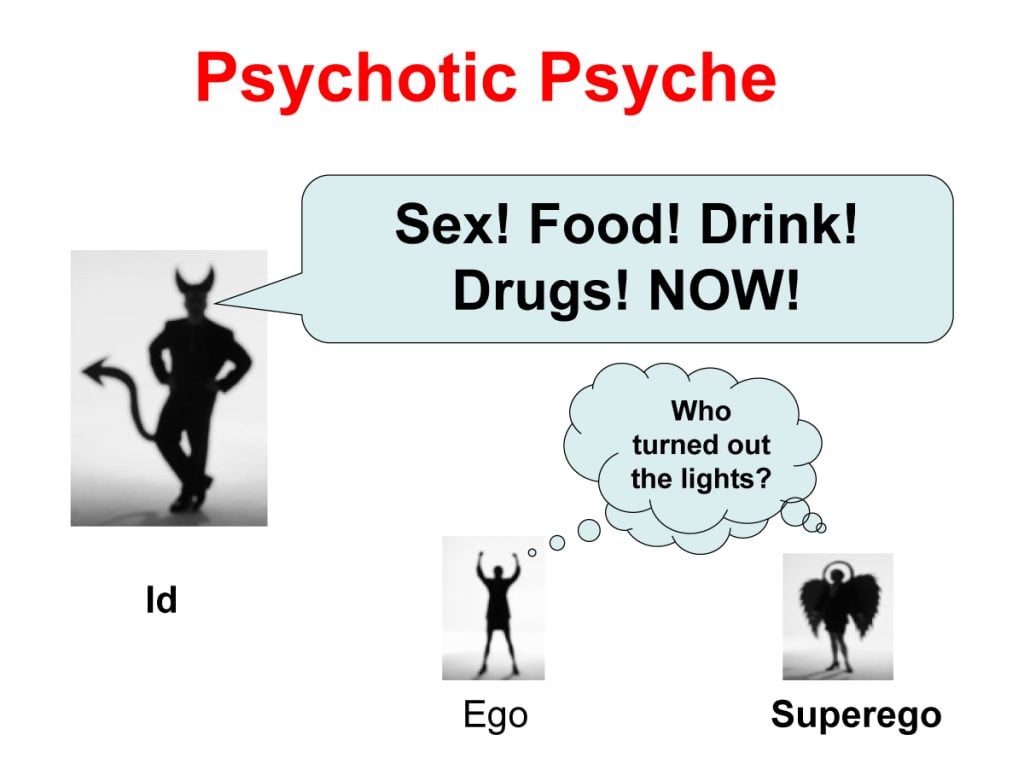
What is the Ego?
Freud’s ego is the rational part of the psyche that mediates between the instinctual desires of the id and the moral constraints of the superego, operating primarily at the conscious level.
The ego is “that part of the id which has been modified by the direct influence of the external world.”
(Freud, 1923, p. 25)
The ego is the only part of the conscious personality. It’s what the person is aware of when they think about themselves and what they usually try to project toward others.
The ego develops to mediate between the unrealistic id and the real external world. It is the decision-making component of personality. Ideally, the ego works by reason, whereas the id is chaotic and unreasonable.
The ego develops from the id during infancy. The ego’s goal is to satisfy the id’s demands in a safe and socially acceptable way. In contrast to the id, the ego follows the reality principle as it operates in both the conscious and unconscious mind.
The ego operates according to the reality principle, working out realistic ways of satisfying the id’s demands, often compromising or postponing satisfaction to avoid negative consequences of society.
The ego considers social realities and norms, etiquette, and rules in deciding how to behave.
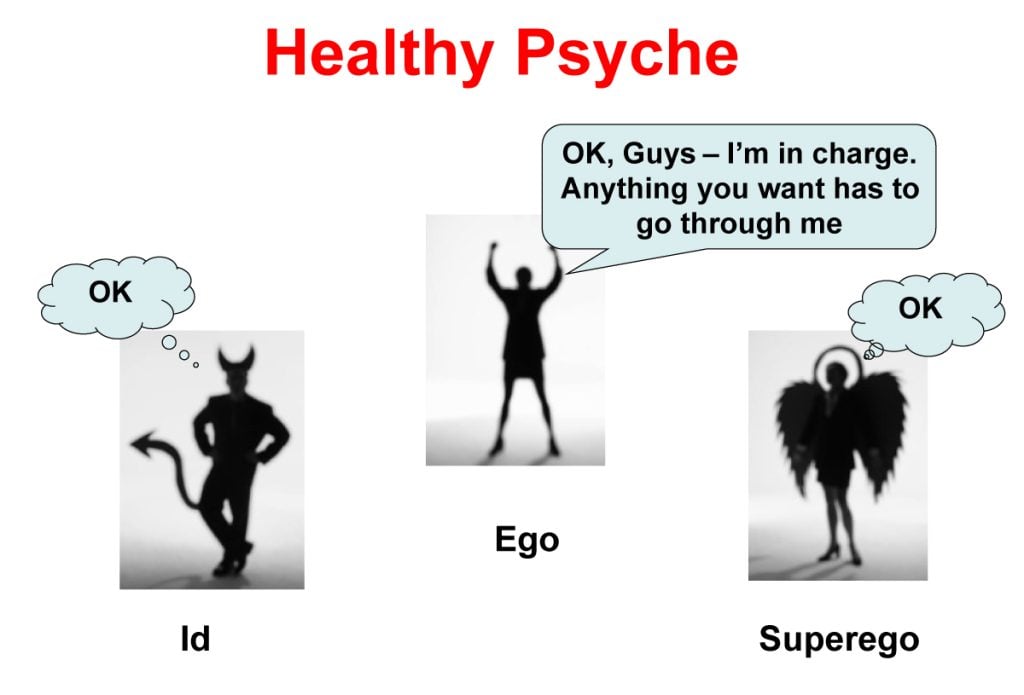
Like the id, the ego seeks pleasure (i.e., tension reduction) and avoids pain, but unlike the id, the ego is concerned with devising a realistic strategy to obtain pleasure.
The ego has no concept of right or wrong; something is good simply if it achieves its end of satisfying without causing harm to itself or the id.
Often the ego is weak relative to the headstrong id, and the best the ego can do is stay on, pointing the id in the right direction and claiming some credit at the end as if the action were its own.
Freud made the analogy of the id being a horse while the ego is the rider. The ego is “like a man on horseback, who has to hold in check the superiour strength of the horse.”
(Freud, 1923, p. 15)
If the ego fails to use the reality principle and anxiety is experienced, unconscious defense mechanisms are employed to help ward off unpleasant feelings (i.e., anxiety) or make good things feel better for the individual.
The ego engages in secondary process thinking, which is rational, realistic, and orientated toward problem-solving. If a plan of action does not work, then it is thought through again until a solution is found.
This is known as reality testing and enables the person to control their impulses and demonstrate self-control, via mastery of the ego.
An important feature of clinical and social work is to enhance ego functioning and help the client test reality through assisting the client to think through their options.
According to Freudians, some abnormal upbringing (particularly if there is a cold, rejecting ‘schizogenic’ mother) can result in a weak and fragile ego, whose ability to contain the id’s desires is limited.
This can lead to the ego being ‘broken apart’ by its attempt to contain the id, leaving the id in overall control of the psyche.
What is the Superego?
Freud’s superego is the moral component of the psyche, representing internalized societal values and standards. It contrasts with the id’s desires, guiding behavior towards moral righteousness and inducing guilt when standards aren’t met.
The superego incorporates the values and morals of society, which are learned from one’s parents and others. It develops around 3 – 5 years during the phallic stage of psychosexual development.
The superego develops during early childhood (when the child identifies with the same-sex parent) and is responsible for ensuring moral standards are followed.
The superego operates on the morality principle and motivates us to behave in a socially responsible and acceptable manner.
The superego is seen as the purveyor of rewards (feelings of pride and satisfaction) and punishments (feelings of shame and guilt), depending on which part (the ego-deal or conscious) is activated.
The superego is a part of the unconscious that is the voice of conscience (doing what is right) and the source of self-criticism.
It reflects society’s moral values to some degree, and a person is sometimes aware of their own morality and ethics, but the superego contains many codes, or prohibitions, that are issued mostly unconsciously in the form of commands or “don’t” statements.
The superego’s function is to control the id’s impulses, especially those which society forbids, such as sex and aggression.
It also persuades the ego to turn to moralistic goals rather than simply realistic ones and strive for perfection.
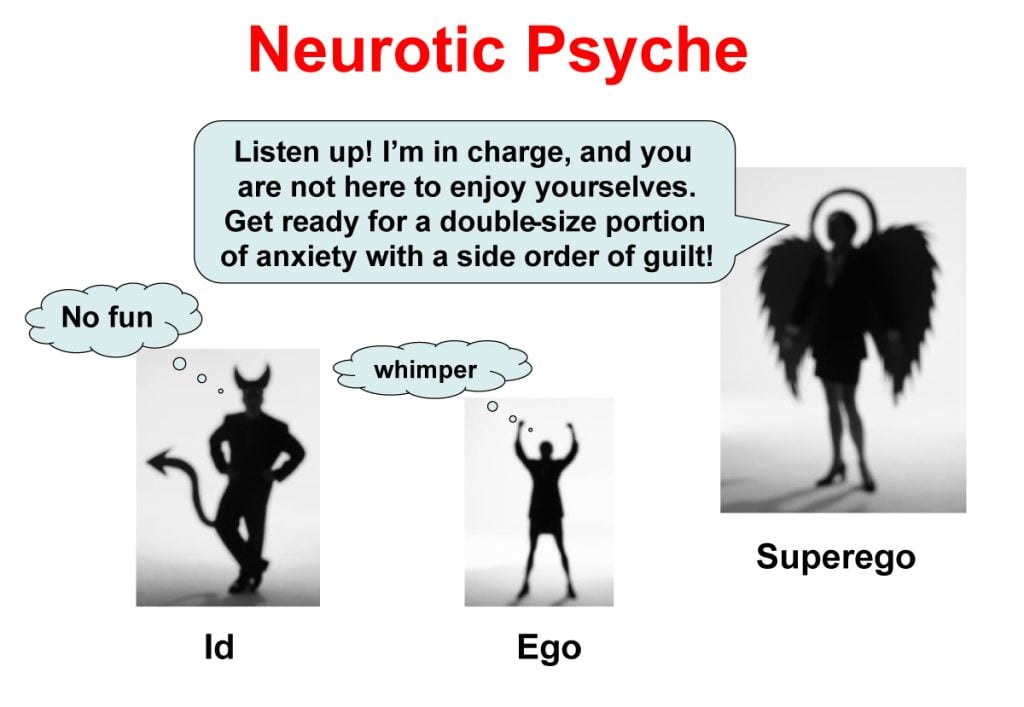
The superego consists of two systems: The conscience and the ideal self.
- The conscience is our “inner voice” that tells us when we have done something wrong.
The conscience can punish the ego by causing feelings of guilt. For example, if the ego gives in to the id’s demands, the superego may make the person feel bad through guilt.
The superego is also somewhat tricky, in that it will try to portray what it wants the person to do in grandiose, glowing terms, what Freud called the ego-ideal, which arises out of the person’s first great love attachment (usually a parent).
- The ideal self (or ego-ideal) is an imaginary picture of how you ought to be, and represents career aspirations, how to treat other people, and how to behave as a member of society.
The assumption is that children raised by parents experience love conditionally (when they do something right), and the child internalizes these experiences as a series of real or imagined judgmental statements.
Behavior which falls short of the ideal self may be punished by the superego through guilt. The super-ego can also reward us through the ideal self when we behave ‘properly’ by making us feel proud.
Guilt is a common problem because of all the urges and drives from the id and all the prohibitions and codes in the superego. There are various ways an individual handles guilt, which are called defense mechanisms.
If a person’s ideal self is too high a standard, then whatever the person does will represent failure. The ideal self and conscience are largely determined in childhood by parental values and how you were brought up.
Examples of the Id, Ego, and Superego
Skipping a workout:
- The id: I want to skip my workout because I feel lazy and just want to relax.
- The superego: I shouldn’t skip the workout because it’s essential for my health and discipline.
- The ego: I can do a shorter workout today and make up for it with a longer session tomorrow.
Buying an expensive item:
- The id: I want this luxury bag now because it’s stylish and will make me feel good.
- The superego: I shouldn’t spend so much on a bag when I could save or use that money for more essential things.
- The ego: I’ll save a portion of my salary for a few months, and if I still want it, I’ll buy the bag as a reward.
Reacting to criticism:
- The id: I’m upset and want to snap back immediately because they hurt my feelings.
- The superego: I should remain calm and composed, taking criticism professionally and not personally.
- The ego: I’ll consider the feedback, see if there’s any truth to it, and respond diplomatically, asking for clarification if needed.
Therapeutic Implications
Freud believed that mental illness is caused by conflicts in the unconscious between the id, ego, and superego.
Neuroses, according to Freud, are caused by an overdominant superego, the resultant defense mechanisms implemented by the ego in an attempt to regain control.
Because the defense mechanisms are being over-used, too much psychic energy is used and allows the maladaptive behavior to emerge. Psychoses, in contrast, are caused by an overdominant id.
According to the psychodynamic approach, the therapist would resolve the problem by assisting the client in delving back into their childhood and identifying when the problem arose.
Identifying the problem can bring this into the conscious, where the imbalance can be resolved, returning equanimity between the id, ego, and superego.
Consequently, the defense mechanisms will only operate at the maintenance level, and the mental illness will be cured.
However, psychoanalysis, the method used to produce this new balance, is time-consuming and costly. Furthermore, no objective measurement can be taken to demonstrate that a cure has been effected; it is reliant on the client’s subjective report of their improvement.
There is concern that clients may claim they are better, not because they are, but because of the time and expense involved.
References
Freud, S. (1920). Beyond the pleasure principle. SE, 18: 1-64.
Freud, S. (1923). The ego and the id. SE, 19: 1-66.
FAQs
What is the difference between the ego and the id?
The id is the primitive, impulsive part of our psyche driven by instincts and desires, while the ego is the rational, conscious part that mediates between the id’s demands and the realities of the external world.
The ego balances the id’s desires with the superego’s moral guidance, striving to maintain harmony within the human psyche.
What is an example of the id ego superego?
An example of the id, ego, and superego interaction can be illustrated through a person on a strict diet who is tempted by a box of delicious donuts at work. The id impulsively desires immediate gratification by indulging in the donuts.
At the same time, the superego reminds the person of their commitment to a healthy lifestyle and instills feelings of guilt for considering breaking the diet.
The ego mediates between the id’s cravings and the superego’s moral standards, potentially allowing the person to eat just one donut as a compromise, demonstrating its role in maintaining psychological balance amidst conflicting desires.
